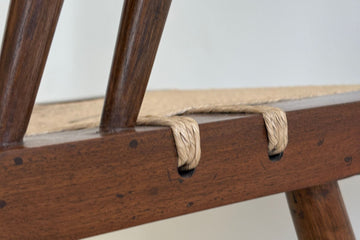Beloved of architects and interior designers, the square-shaped seat and rounded back have made this Nakashima-inspired grass-woven chair an icon of mid-century design. But the story of this enduring piece, and indeed much of George Nakashima's philosophy, has roots in a transformative sojourn to India.
George Nakashima first journeyed to India in 1936, embarking on a year-long architectural adventure working for Czech modernist Antonin Raymond on a project for the Sri Aurobindo Ashram in Pondicherry. This period proved to be far more than just a professional engagement; it was a profound immersion into a different way of life, a confluence of traditional craftsmanship and spiritual thought that would forever color his artistic vision.
In India, amidst the vibrant culture and ancient traditions, Nakashima encountered woodworking practices deeply intertwined with the land and its resources. He witnessed the skill and artistry of local craftsmen, their intimate understanding of materials, and their patient, time-honored techniques. This exposure ignited a spark within him, a departure from the large-scale architectural projects he had been involved in. He began to explore the intimate relationship between form and function on a smaller scale, experimenting with furniture design using the very materials and hands that surrounded him.
It was during this formative time and subsequent visits that Nakashima conceived of simple, functional pieces that spoke to both Japanese aesthetics – a heritage he carried within him – and the earthy, grounded spirit of India. Low-lying chairs, sturdy stools, and unpretentious tables began to take shape under his guidance and the skilled hands of local artisans. The grass-seated chair emerged as a particularly resonant creation. Imagine the scene: Nakashima, perhaps sketching his ideas under the warm Indian sun, collaborating with local weavers to transform indigenous grasses into comfortable, textured seats, supported by the honest simplicity of wooden frames. This chair wasn't just furniture; it was a tangible expression of cross-cultural dialogue, a testament to the beauty found in natural materials and collaborative craftsmanship.
Nakashima's time in India wasn't just about observing techniques; it was a deep dive into spiritual philosophies that emphasized the interconnectedness of all things and the inherent beauty of the natural world. These principles became cornerstones of his later work, informing his reverence for wood, his commitment to highlighting its natural grain and imperfections, and his belief in creating pieces that possessed a timeless, almost spiritual quality.
The grass-seated chair, therefore, stands as a potent symbol of this pivotal period in Nakashima's life. It embodies the simplicity he discovered in India, the beauty he found in local materials, and the power of collaborative creation. It serves as a reminder that sometimes, the most iconic designs are born from unexpected journeys and the profound influence of different cultures.


